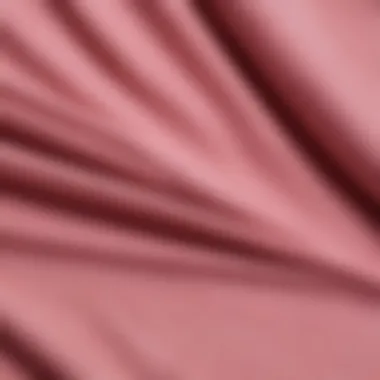The Allure of Pink T-Shirts in Men's Fashion Trends


Intro
The trend of pink t-shirts for men is gaining traction and sparking interest in various fashion circles. This rising popularity is not merely a fad but reflects a shift in cultural perceptions surrounding masculinity and color choices. As we venture into this exploration, we will delve into several facets that contribute to the appeal of pink t-shirts.
Understanding the history, style versatility, and consumer preferences surrounding this garment will offer a rich narrative regarding its position in modern menswear. From the significance of fabric choices to how social media plays a role in shaping perceptions, the discussion captures key elements that define these garments.
Throughout this article, you will find insights that are both instructional and analytical, providing a comprehensive look at how pink t-shirts have found their niche in contemporary men's fashion.
The Cultural Shift Towards Pink
Historical Context
Traditionally, color associations have dictated what is deemed suitable for men and women. Historically, pink was once considered a masculine color, believed to symbolize strength. However, in the early 20th century, marketing began targeting pink as a feminine color. This shift led to a long-standing perception, until recent years when societal norms began to evolve once again.
The Rise of Gender Neutral Fashion
Today, the rise of gender-neutral fashion is a defining influence in the acceptance of colors traditionally labeled as feminine. Pink t-shirts have become emblematic of this broader trend, shaking off antiquated perceptions and embracing individual identity. This reimagining has led to a greater acceptance of pink in men's wardrobes, allowing personal expression to flourish.
The Versatility of Pink T-Shirts
Styling Options
Pink t-shirts are celebrated for their versatility. They can be paired with various garments and styles. Here are some key pairing options:
- Casual Wear: Pair with shorts or jeans for a relaxed look.
- Work Attire: Combine with blazers for a modern office outfit.
- Athleisure: Great for gym wear when matched with joggers.
These options highlight how pink t-shirts fit into diverse scenarios, appealing to a wide range of preferences and lifestyles.
Fabric Choices
The choice of fabric also influences the appeal of pink t-shirts. Cotton, polyester blends, and luxurious materials have distinct impacts on comfort and appearance. As consumers lean towards sustainable options, organic cotton shirts are gaining popularity. They provide breathability while promoting eco-consciousness.
Preface to Pink T-Shirts
The rise of pink t-shirts in men's fashion is a reflection of broader societal shifts. This section examines the significance of this trend. In recent years, men's fashion has experienced a transformation, with colors previously considered traditionally feminine gaining acceptance among men. Pink, in particular, has become a staple in wardrobes, signifying a break from conventional gender norms and an embrace of individual expression.
Historical Context
Historically, pink was not always associated with femininity. In the early 20th century, pink was considered a masculine color, often chosen for baby boys. It wasn't until the mid-20th century that societal perceptions changed. Marketing and cultural influences began to associate pink primarily with women. This shift highlights how arbitrary color perceptions can be. By understanding this history, one begins to appreciate how pink t-shirts have regained their place in men's fashion.
"Color perceptions have changed dramatically over the decades, showing the fluidity of societal norms."


The resurgence of pink t-shirts today can be traced back to movements promoting gender equality and individuality. Men have started to challenge outdated notions of masculinity, allowing colors such as pink to signify strength and confidence rather than softness.
Cultural Evolution of Color Perceptions
Color perception is deeply rooted in culture and can evolve over time. Pink's journey symbolizes a broader change in how society views masculinity. In many cultures, colors are assigned gender roles that impact fashion choices. However, as these boundaries blur, pink emerges as a color of choice for many men.
The presence of pink in high fashion and celebrity endorsements played a significant role in this evolution. As designers increasingly embrace pink in their collections, it becomes a statement of modern masculinity. The global fashion industry, through its marketing strategies, reinforces this acceptance by normalizing pink t-shirts for various occasions.
In summary, understanding the historical and cultural contexts surrounding pink t-shirts illuminates their significance in today's fashion landscape. This analysis prepares us to delve deeper into their appeal in men's fashion and their growing versatility.
The Appeal of Pink in Men's Fashion
The significance of pink t-shirts in the realm of men's fashion is more than a passing trend; it signifies a substantial shift in cultural norms and our understanding of color psychology. The growing acceptance of pink as a staple in men's wardrobes illustrates changing attitudes toward masculinity and personal expression. This section will delve into two primary aspects: breaking gender norms and the psychological effects of color, which ultimately contribute to the expanding appeal of pink garments for men.
Breaking Gender Norms
Historically, pink has been viewed as a feminine color, entrenched in social constructs that dictate acceptable colors based on gender. However, the landscape of fashion is evolving. Men are increasingly defying traditional expectations and embracing colors that were once deemed unconventional for their gender. Wearing a pink t-shirt is more than about aesthetics; it is a statement of individuality and empowerment.
This shift is reflected in various fashion lines and designers who have actively incorporated pink into their collections for men. Celebrities and influencers are also a driving force behind this trend, showcasing their stylish pink t-shirts on social media platforms like Instagram and Facebook. By normalizing the color in mainstream men's fashion, they challenge outdated gender stereotypes.
Additionally, embracing pink can foster a sense of community among those who choose to wear it. Men proudly donning pink as a symbol of their identity may inspire others to take similar bold steps, further breaking down barriers.
Psychological Impact of Color
Colors evoke specific emotions and can significantly influence one's mood. Pink, often associated with warmth, calmness, and compassion, has an interesting psychological appeal. Research suggests that pink can evoke feelings of comfort and security. Therefore, wearing a pink t-shirt may contribute to a more relaxed and confident demeanor.
Furthermore, studies indicate that colors play a role in personal branding. Men who wear pink might be perceived as approachable and friendly, qualities that can enhance social interactions and perceptions in professional settings. The psychological impact of wearing pink thus extends beyond the individual, influencing how others perceive them.
In summary, the appeal of pink in men's fashion goes beyond aesthetic choices; it embodies a progressive movement toward breaking down gender norms and enhancing self-perception through color. As society continues to evolve, the pink t-shirt remains a vital element in men's style, reinforcing both personal expression and psychological well-being.
Versatility of Pink T-Shirts
The versatility of pink t-shirts is a vital aspect in the discourse surrounding men's fashion. This element contributes significantly to their popularity. Pink t-shirts serve various purposes, demonstrating adaptability across different settings. This adaptability makes the pink t-shirt a staple in many wardrobes. Whether for casual outings, active engagements, or more layered looks, the pink t-shirt can fit seamlessly into diverse contexts.
Casual Wear
Casual wear is where pink t-shirts find a significant role. They lend a relaxed yet stylish vibe to any outfit. When worn gently, a pink t-shirt can contrast sharply with darker pants, creating a balanced look. Pairing them with jeans, shorts, or chinos offers flexibility. The soft color of pink often communicates a laid-back attitude, appealing to those seeking comfort without sacrificing style. This makes pink t-shirts not just clothing, but a statement about personal style.
Active Wear
In the realm of active wear, pink t-shirts also stand out. Many men are embracing this color while engaging in sports or fitness activities. The bright hue often conveys energy and enthusiasm. Brands are recognizing this trend, producing athletic t-shirts in shades of pink that often utilize technical fabrics for enhanced performance. These materials wick away moisture, ensuring comfort during intense workouts. Thus, pink t-shirts in this context serve dual purposes: they look good while also functioning well.


Layering and Styling Options
Pairing with Different Colors
Pairing pink t-shirts with other colors presents intriguing styling opportunities. The subtle yet striking nature of pink allows it to blend seamlessly with many hues. For example, combining it with earth tones can create a refined look, while bright colors can generate a more playful outfit. This versatility in pairing enhances the t-shirt’s role in a man’s wardrobe. However, it is essential to consider shade compatibility carefully. Mismatched tones could detract from the overall look.
Accessorizing the Look
Accessorizing a pink t-shirt can elevate the outfit significantly. Simple additions, like a watch or bracelets, can complement the pink hue. The beauty of accessorizing is that men can personalize their looks. A dark watch or a leather bracelet, for instance, can create a strong focal point against the softness of pink. However, there is a delicate balance to maintain. Over-accessorizing could lead to a cluttered look, which is the opposite of the effortless vibe often associated with pink t-shirts.
Seasonal Adaptations
The adaptability of pink t-shirts in various seasons further emphasizes their versatility. In warmer months, lighter shades of pink can provide a refreshing look. As seasons change, darker pinks are favored during colder months. This flexibility allows men to wear pink t-shirts year-round. Additionally, layering with jackets or cardigans can create a cohesive look in winter. The unique feature here is that a pink t-shirt can transition seamlessly, making it a valuable addition to any wardrobe. However, it is crucial to pay attention to fabric choices that can complement seasonal needs.
Material Selection and Quality
Material selection and quality are instrumental in determining the appeal and functionality of pink t-shirts for men. The fabric choice can influence comfort, durability, and style, impacting how the garment is perceived in the fashion market. As the trend of pink t-shirts rises, understanding material attributes becomes crucial for both consumers and brands.
Fabric Choices
Cotton and Blends
Cotton is often revered for its softness and breathability. Pink t-shirts made from 100% cotton offer a comfortable wear experience, perfect for casual outings. The natural fibers allow for moisture absorption, making them ideal for warmer weather. A blend of cotton with synthetic fibers, like polyester, enhances durability and wrinkle resistance. This combination extends the life of the garment, an essential factor for longevity in men's fashion. Although cotton t-shirts can be prone to shrinking and fading over time, the tactile nature remains a strong selling point. Most consumers appreciate the familiar feel of cotton against their skin.
Technical Fabrics for Sportswear
Technical fabrics are increasingly a popular choice for sportswear, including pink t-shirts. These materials often include polyester or nylon, which offer moisture-wicking properties. They efficiently draw sweat away from the body, keeping the wearer dry during activities like running or cycling. Lightweight and quick-drying, these fabrics are advantageous for those engaged in high-intensity sports. However, while technical fabrics excel in performance, they may lack the softness associated with cotton, which might deter some consumers. It is important to recognize the balance between functional benefits and the comfort preferred in everyday wear.
Sustainability Considerations
Sustainability in fashion, including pink t-shirts, has garnered significant attention. The fashion industry is under scrutiny for its environmental impact. Consumers are increasingly seeking garments produced with eco-friendly materials and manufacturing processes. Bamboo and organic cotton are two alternatives gaining traction. Brands that prioritize sustainability not only contribute positively to the environment but also appeal to a growing demographic of environmentally conscious consumers. By investing in sustainable options, the market demand for pink t-shirts can align with the emerging values of today's consumers.
Marketing Trends and Branding
Marketing trends and branding play a crucial role in shaping the appeal of pink t-shirts for men. The rise of pink in men's fashion is not merely a clash against traditional gender norms; it is also a reflection of how products are positioned by brands in the marketplace. Understanding these trends aids in grasping why pink t-shirts have gained popularity and how they fit into a broader narrative of masculinity.
Influence of Social Media
Social media has rapidly changed the fashion landscape. Platforms like Instagram, TikTok, and Facebook have become vital for brands looking to capture the attention of consumers. In recent years, social media influencers have adopted pink t-shirts, promoting them as statements of personal style. This phenomenon has led many young men to reconsider their color choices in clothing, helping pink to transition from a historically feminine color to a staple in men's wardrobes.
- The rise of micro-influencers has also contributed to this trend. Their ability to connect with niche markets means that their endorsement of pink t-shirts can have a substantial impact on buying decisions.
- Hashtags like #PinkForMen have also gained traction, creating a community around the color choice that empowers men to express individuality.


“Social media empowers men to break traditional norms and adopt bold choices like pink.”
The engagement on these platforms aids brands in understanding consumer preferences in real-time, allowing for agile marketing strategies that resonate with specific target audiences.
Brand Collaborations
Brand collaborations have further accelerated the acceptance of pink t-shirts among men. Collaborations between high-profile designers and mainstream clothing brands have created unique collections that often include pink pieces, pushing boundaries and emphasizing versatility.
- Notable collaborations: Several brands have collaborated with celebrities who embrace the pink aesthetic, bridging the gap between luxury and everyday wear.
- Limited-edition drops: These campaigns often create urgency and exclusivity, which entice consumers to purchase items that may not ordinarily be in their wardrobe.
This interplay between branding and consumer behavior reflects a changing tide toward color neutrality in fashion. Men are becoming more open to experimenting with attire that expresses personality, breaking free from traditional color assignments. As such, brands that invest in these marketing trends not only attract attention but also contribute to a significant cultural shift.
Consumer Preferences and Market Demand
Understanding consumer preferences and market demand is crucial in the context of pink t-shirts for men. This section explores why these factors are significant in shaping the trend. The popularity of pink t-shirts reflects a shift in cultural attitudes towards color and gender expression. There is a growing acceptance of non-traditional color choices in menswear, and pink is at the forefront of this change.
To meet this rising demand, brands are not only diversifying their offerings but also re-evaluating marketing strategies. These elements highlight how consumer interests influence production and style choices in this segment of fashion.
Target Demographics
The target demographics for pink t-shirts include a broad spectrum of consumers. Traditionally, men’s fashion catered to specific color palettes, primarily blues, blacks, and grays. Now, men of various age groups and backgrounds embrace pink as a viable choice. Young adults, particularly those aged 18-35, are more likely to adopt this color in their wardrobes. This demographic is often influenced by digital trends and social media, where pink t-shirts are often depicted in casual and adventurous settings.
Moreover, the acceptance of pink extends beyond youth culture. Older generations are also embracing this color, appreciating its versatility and its ability to signify confidence and individuality. Therefore, brands are adjusting their marketing approaches, taking into account these diverse consumer personas while tailoring communication to resonate with each group.
Price Trends
Price trends are another essential aspect to consider. The market for pink t-shirts shows a range of price points. Basic styles from brands like H&M or Uniqlo typically offer affordability, while premium brands such as Ralph Lauren or Hugo Boss present higher-end options. This variance allows consumers to choose based on their budget while still participating in the trend.
As the demand for sustainable and ethically made clothing grows, consumers are willing to invest more in premium products that align with their values. This shift reflects an increasing awareness of quality over quantity.
Studies indicate that the average price for a pink t-shirt has steadily increased by 12% over the past five years, driven by sustainability factors and enhanced fabric technologies.
In summary, understanding consumer preferences and market demand is vital to grasp the significance of pink t-shirts in modern menswear. This awareness enables brands to strategically position themselves in a crowded marketplace, catering to a diverse consumer base that values both style and substance.
Culmination
The discussion about pink t-shirts for men is essential in understanding modern fashion dynamics. This article has dissected various elements that contribute to the appeal of this garment.
Future Outlook for Pink T-Shirts
We can expect the trend of pink t-shirts to grow in the coming years. Many brands are beginning to embrace diverse color palettes, challenging traditional perceptions of masculinity. This shift provides opportunities for innovation in styles and designs.
- Increased Acceptance: As society becomes more open to non-traditional color choices, the market will continue to expand. We already see pink being celebrated on runways and in casual wear.
- Sustainable Practices: With growing awareness of sustainability, brands focusing on eco-friendly materials will likely drive demand further. Consumers are increasingly looking for both style and ethical production.
- Influence of Streetwear: Streetwear culture continues to resonate deeply. Pink t-shirts are being integrated into this style, suggesting a potential rise in casual, yet fashionable, outings.
Embracing Individual Style Choices
Ultimately, the appeal of pink t-shirts lies in their versatility and the ability they give men to express their individuality. As men challenge fashion norms, personal style becomes a statement of confidence.
- Expression of Personality: Wearing pink can signify an avant-garde or playful attitude. It invites conversations and reflects one's personality.
- Layering Opportunities: Pink t-shirts can be effortlessly layered with jackets or sweaters. This offers room for creative styling, making everyday outfits unique.
- Attracting Attention: As men confidently wear pink, they draw positive attention. This encourages others to reconsider their own fashion choices, broadening the spectrum of accepted styles.







